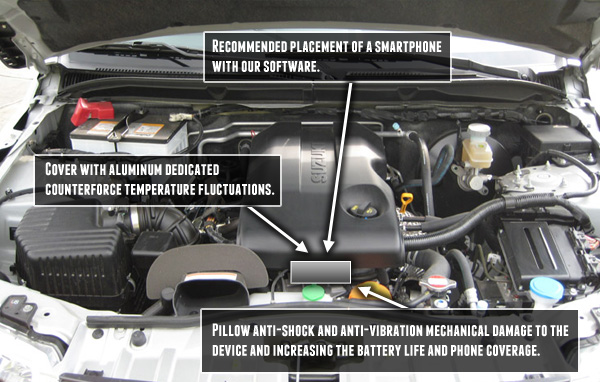
Suzuki Grand Vitara Mk2 GPS Tracking
Track your Grand Vitara Mk2 for free and visualize it on map
Produced to: today
How to track your favourite Suzuki - model Grand Vitara Mk2 in realtime for free ?
Producer remarks about this particular model
Suzuki Grand Vitara II was introduced in 2005. The vehicle was built on the floorpan of General Motors called Theta, for which they were created, among others, Opel Antara, Chevrolet Captiva, Cadillac SRX and Saab 9-4X. The car is powered by a permanent four-wheel drive, center differential, its lock and reducer.Our product description
We are offering you completely free of charge our GPS car tracking solution in real time. The only thing you need to do is to install smartphone with Android inside your vehicle with our awesome application on board
If you want to track your Suzuki Grand Vitara Mk2 in real time you have to do the following :
1. Download Free Car Tracking Application for Grand Vitara Mk2 application from Google Play
2. Create free account on spysat.eu (for example johndoe) - here is detailed instruction
3. Define Device endpoint for each vehicle you want to track - give friendly name of your Grand Vitara Mk2 and PIN (some random will be provided - you can change it if you want)
4. Run SpySat mobile application on the smartphone and type there your LOGIN from SpySat (ex. johndoe) and PIN (from point 3.)
5. Install your smartphone inside the car
6. Enjoy watching position of your car at spysat.eu site.
7. Provide stable power supply - spysat app consumes some energy.
Best options to install smartphone inside Suzuki Grand Vitara Mk2

Engineers found that the engine of the car alternator awful shakes. For this reason, use double lining made of a special material anti vibrating. You should be aware that it does not apply this product will result in damage to the device.
Thank you for your inquiry. To permanently mount a smartphone inside Suzuki Grand Vitara Mk2, we recommend using a custom-made silicone case or waterproof case designed specifically for this purpose. These cases will provide protection to your phone while allowing it to be securely mounted in the center console box.To ensure a permanent direct connection to the battery, you can purchase an aftermarket wiring kit that is compatible with your specific model year of the Suzuki Grand Vitara Mk2. This kit will allow you to connect the case directly to the car's battery, ensuring that your phone remains powered at all times.
For GPS tracking applications, we recommend using our free app that can be downloaded from our website. The app provides features such as GPS tracking and location monitoring for your vehicle.
In terms of maintenance tips, it is recommended to clean the air filter regularly and check the engine oil level frequently. Additionally, regular inspections and tune-ups are essential in maintaining optimal performance of your Suzuki Grand Vitara Mk2.
We hope this information helps you with permanently mounting your smartphone and using it as a GPS tracker application in your Suzuki Grand Vitara Mk2. If you have any further questions or concerns, please do not hesitate to ask.
Users opinions and questions
Frequently Asked Questions:
What specific features and performance improvements can be expected from the 2006 Suzuki Grand Vitara Mk2 model compared to its previous versions?
The 2006 Suzuki Grand Vitara Mk2 comes with several notable features and performance improvements compared to its predecessors. Here are some of them:1. Design: The exterior design of the 2006 model is more aerodynamic, sleeker, and modern-looking than previous versions. It also has a larger overall size, which provides more interior space for passengers.
2. Engine: The 2006 Suzuki Grand Vitara comes with two engine options - a 2.4L DOHC VVT four-cylinder engine and a 3.2L DOHC VVT V6 engine. Both engines offer improved performance, better fuel efficiency, and reduced emissions compared to previous models.
3. Transmission: The 2006 model comes with a choice of either a five-speed manual or a four-speed automatic transmission. The automatic transmission features a "Sport Mode" that allows the driver to select between three different shift patterns for enhanced performance.
4. Suspension: The 2006 Suzuki Grand Vitara Mk2 has an updated suspension system that offers better ride quality, handling, and stability compared to previous versions. It also comes with larger brake rotors and upgraded braking components that provide improved stopping power.
5. Interior: The interior of the 2006 model is more spacious and comfortable than previous versions. It features updated seating materials, a new center console design, and an upgraded audio system. The vehicle also comes with a range of standard and optional features such as air conditioning, power windows, and a CD/MP3 player.
6. Safety: The 2006 Suzuki Grand Vitara Mk2 comes with several safety features that were not available in previous models. These include electronic stability control (ESC), traction control, brake assist, and hill descent control. It also comes with advanced airbags, side-impact beams, and a reinforced body structure that provides better protection in the event of a collision.
Overall, the 2006 Suzuki Grand Vitara Mk2 is a significant improvement over previous models in terms of design, engine performance, transmission options, suspension, interior comfort, and safety features.
What are the key differences between the Suzuki Grand Vitara Mk2's engine options, and how do these affect performance and fuel efficiency?
The Suzuki Grand Vitara Mk2 (also known as the second-generation Suzuki<|im_start|> Grand Vitara) was produced from 1998 to 2005. It came with three main engine options during its production run, which are:1. 2.0 L J2K I4 Gasoline Engine: This engine produces 136 hp and 130 lb-ft of torque. It is a naturally aspirated inline four-cylinder gasoline engine. This engine offers decent power for everyday driving, but it's not the most powerful option available on the Grand Vitara Mk2. Fuel efficiency is also average, with an estimated 23 mpg in the city and 28 mpg on the highway.
2. 2.5 L J25 I4 Gasoline Engine: This engine produces 160 hp and 167 lb-ft of torque. It is also a naturally aspirated inline four-cylinder gasoline engine, but with more power than the 2.0L engine. The extra horsepower and torque make this engine option better for those who want a little more performance out of their Grand Vitara Mk2. Fuel efficiency is slightly lower compared to the 2.0L engine, with an estimated 21 mpg in the city and 25 mpg on the highway.
3. 2.7 L V6 Gasoline Engine: This is the most powerful engine option available for the Grand Vitara Mk2. It produces 180 hp and 184 lb-ft of torque. The V6 engine offers a significant boost in power compared to the other two engines, making it ideal for those who want a sportier driving experience or plan on doing some off-roading. However, this comes at the cost of reduced fuel efficiency, with an estimated 18 mpg in the city and 23 mpg on the highway.
In summary, the key differences between the engine options are power output and fuel efficiency. The 2.0L engine offers decent performance and good fuel efficiency, while the 2.5L provides more power but slightly lower fuel efficiency. The 2.7L V6 is the most powerful option but has the lowest fuel efficiency of the three engines. Ultimately, your choice will depend on your personal preferences and needs as a driver.
As a car salesman at a Suzuki dealership, what promotional offers and financing options are available for the Suzuki Grand Vitara Mk2 this month?
This month, our Suzuki dealership is offering exciting promotions and financing options on the Suzuki Grand Vitara Mk2. To encourage customers to purchase this SUV, we have a range of attractive deals including:1. Low monthly payments: We're providing flexible financing options with low monthly installments for qualified buyers who finance their Grand Vitara Mk2 through our dealership.
2. Cash rebates: Customers can avail cash rebates on the purchase of the Suzuki Grand Vitara Mk2, making it a great time to buy.
3. Lease deals: If you prefer leasing your vehicle instead of buying, we have competitive lease options available for the Grand Vitara Mk2.
4. Complimentary accessories: With each purchase of the Suzuki Grand Vitara Mk2 this month, customers will receive complimentary floor mats and cargo tray as part of our promotion.
5. Extended warranty: To ensure peace of mind, we're offering an extended warranty plan that covers your Grand Vitara Mk2 beyond its factory warranty period.
6. Trade-in value: If you have a used car to trade-in, we'll provide a fair market value for it as part of our trade-in program.
7. Special discounts for military personnel and first responders: As a show of appreciation, we offer special discounts on the Suzuki Grand Vitara Mk2 for active military personnel and first responders.
These promotional offers are subject to change without notice, so make sure you visit our dealership or contact us for the most up-to-date information on deals and financing options available for the Suzuki Grand Vitara Mk2 this month.
How do I diagnose and repair the common engine misfire issue on a 2006 Suzuki Grand Vitara Mk2, specifically related to the I4 2.4L DOHC engine?
Diagnosing and repairing an engine misfire on a 2006 Suzuki Grand Vitara MK2 with a 2.4L DOHC engine involves a multi-step process. Here's how you can diagnose the problem and make necessary repairs:1. Check Engine Light (CEL) Diagnosis:
The first step is to connect your OBD-II scanner to the vehicle's diagnostic port located under the dashboard on the driver side. Scan for any stored codes related to misfire or engine performance issues. This can help you determine if it's a specific cylinder that's experiencing a misfire.
2. Visual Inspection:
Perform a visual inspection of the engine bay, paying close attention to the spark plug wires and coil packs. Look for any signs of damage, wear, or corrosion. Also, inspect the fuel injectors for clogs or leaks.
3. Spark Plug Check:
Remove each spark plug one at a time and inspect them visually for signs of fouling (black soot) or pre-ignition (white ash). Use a spark plug tester to check if they're producing a strong spark. Replace any faulty spark plugs with OEM replacements.
4. Coil Pack Inspection:
Inspect the coil packs for damage and ensure all connections are secure. Test each individual coil using a multimeter to measure its resistance. If you find any coils that have high resistance, replace them with OEM parts.
5. Fuel Injector Check:
Test the fuel injectors using a pressure tester or scan tool that supports live data streaming. Look for signs of leaks, clogs, or weak spray patterns. If you notice any issues, clean the injectors using an approved cleaner or replace them if necessary.
6. Fuel Pump Test:
Check the fuel pump by listening for proper operation while revving the engine or use a fuel pressure gauge to measure the system pressure at idle and under load. Replace the fuel pump if necessary.
7. Ignition Timing Adjustment:
Using a timing light, verify that the ignition timing is within specification. If needed, adjust the timing using the appropriate procedure for your vehicle model.
8. Compression Test:
Perform a compression test on each cylinder to check if there's any leakage between the pistons and cylinder heads. Look for differences in readings between cylinders that could indicate a blown head gasket or other internal damage.
9. Reassemble and Road Test:
After completing all necessary repairs, reassemble everything back together and road test the vehicle to verify if the misfire issue has been resolved. If it persists, consult a professional mechanic for further diagnosis.
Remember always to follow your vehicle's service manual when performing any diagnostic or repair procedures.